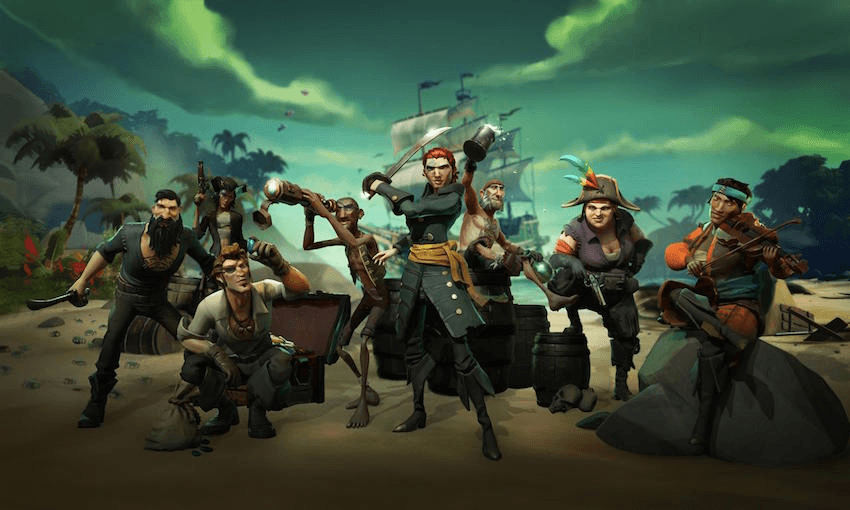In January, Sam Brooks made a studio visit to Rare Studios outside Birmingham in the UK to play the studio’s game Sea of Thieves, currently in open beta. He tells the story of an enchanting and slightly bizarre trip with a group of gregarious goofs.
You start off in a bar, with four strangers around you. You’re all pirates holding tankards. You take a swig, and then you all head for the pirate ship. There’s a big-hearted cartoon-like feeling to the entire thing. You could be playing inside a Saturday morning cartoon, where nothing too bad is going to happen to anybody – and if anything bad does happen, it’s going to be wrapped up within the next 22 minutes. You and your new pirate friends get on a ship and set off on a mission; you work together, you all reap the benefits.
That’s Sea of Thieves. The vibe of the game is intoxicating, much like the tankard you can wield for absolutely no reason other than that it’s fun and silly to do so. You’re sucked in immediately
That is also, coincidentally, the same vibe that permeates Rare Studios.
Birmingham is cold in winter. It’s also dark. As I’m driven out to the Rare Studios, that’s the first thing that comes to mind. The next – the question of how a company that makes such warm, involving and caring games can come from a city that looks like they filmed Children of Men there and forgot to take down the sets.
When you think of game studios, you think of dark corridors, you think of HAL 9000, you think of somewhere cold and uninviting. That’s not the vibe at Rare Studios at all. Even though it’s in a location so remote you feel like you’re about to walk into Broadchurch, there’s an almost family-like feeling to the place. There’s a football field. There’s an in-house cafeteria with better food than I can get anywhere near the downtown Auckland office I’m currently working in. There’s light! Actual, proper sunlight.
It doesn’t feel like a tech hub – it feels more like an artist’s studio.
Since its foundation in 1985, Rare Studios has made some of the most critically acclaimed games of all time. They’re games that have stood the test of time not only commercially but in the hearts of gamers both serious and casual. There’s the legendarily difficult Battletoads from the 8-bit era; the still-beloved first-person shooter Goldeneye: 007, still regarded as one of the best first-person shooters to ever be released and the best movie-to-video game by a country mile; the off-beat platformer Banjo Kazooie; the not-so-secretly filthy Conker’s Bad Fur Day; and the bright-as-fireworks life simulation Viva Pinata.
There’s an element of warmth, life and love to Rare Studios games that is unique among their competitors. Other games can often feel overly market-tested or like they’re trying to rehash past successes, attempting to make ungainly squares fit into old circle-shaped holes. You don’t get that feeling from Rare.
And you definitely don’t get that feeling from Sea of Thieves.
I got the chance to talk to Joe Neate, the executive producer on Rare’s new game, about the development of the game, their values in creating it, and the experiences that the studio wanted the game to create for the players – and also for the players to create for themselves within the game. “We were looking at what we call shared world games, and our vision was players creating stories together. That was the original pitch before we even came up with pirates,” he says.
“We wanted to create a game that championed the use of soft skills – social skills – and create something that gave you a positive social experience, which isn’t always the case in some video games.”
Sea of Thieves achieves that. I only had a short-ish time to play it, with a group of strangers I’d met maybe an hour beforehand, but we quickly found ourselves creating narratives together. It’s not the mammoth world of Pirates of the Caribbean – though it has the scope to be that in future – but even the little mini-narratives our crew of four made for each other felt like meaningful experiences: crashing into rocks and frantically having to patch up our ship, or constantly rotating our roles on the ship before settling on what we were all ‘best’ at (I was ‘best’ at steering, or at least the least terrible at it compared to the other roles), or me running around killing chickens (because the game lets a monster like me do that) and crashing our session.
I am notoriously bad at multiplayer online games, which is why I tend to avoid them. But while there’s skill involved in Sea of Thieves, how quickly and accurately can you point a weapon or how well can you interact with the interface mean so much less than simply communicating and building a bond with your crew.
This is a key part of the game, according to Neate. “There’s been a lot of thinking that’s gone into this, because we believe so strongly in the magic of multiplayer, and that online interactions don’t need to be shitty. You can have great online interactions, and if we create a game that has the right aspiration, the right guidelines, the right kind of player rules, then we can get people to behave in a really positive way.”
This kind of thing is incredibly refreshing to hear. I’m someone who stays away from online games for that very reason – no matter how fun a game is, if I have to play with a bunch of shitheads or people throwing around barely articulated rage, it’s not worth it. A company actively creating an online multiplayer that not only allows but encourages positive social experiences is a big deal.
Beyond the emphasis on positive interaction, the game is also consciously inclusive, and not in a cop-car-pride-flag sort of way. It’s inclusive because the studio genuinely wants their player base to feel included and feel better about playing the game. “Even the clothing choices within the game, allowing people to dress how they want, was something that we pushed so hard on. Players should be able to select who they want to be in the front end, dress how they want to dress, with no restrictions. Everybody has access to all of it; it’s player choice.”
You get the same kind of feeling when you walk around Rare Studios – even in the places that you wouldn’t normally take note of in a studio tour (says the guy who been on exactly one of these things). The staff are an unpretentious and unshowily diverse group of people who seem genuinely chill and happy to work there. And that kind of chillness and happiness seems to have permeated, both psychically and consciously, into the game they’re working on.
What a game like Sea of Thieves can do is perhaps summed up best in the story of Clumsy George. Neate gets animated and surprisingly emotional when he talks about Clumsy George, a member of the very active forum community that Rare Studios have cultivated as a core part of their development and feedback process.
“He writes the most incredible, eloquent posts – he’s like the poet. I know so much about this guy, and so does the community because he writes his whole backstory, and everything on his mind just kind of comes out. He saw this game, and had been put off multiplayer from other games – I think he thinks he speaks a bit funny with his accent and thinks he’s not very good at games.
“So when he entered this game it was his last hurrah of playing in a multiplayer space, and now he’s one of the core members of the community and he loves it. His posts are something to look forward to, we’ve sent his stories all around the studio – and it meant so much to us that we actually renamed one of the taverns the George & Kraken. We’ve been doing this a lot for our players – the players for whom the game means so much, and who mean so much to the game – and his story really resonates with me because he is an example of everything we’ve wanted to do, which is to create a multiplayer game that allows someone who has been put off by them to come in and have a safe social space. I’m proud of what we’re doing for many reasons, but that’s definitely one of them.”
Through all the features and all of the fun of Sea of Thieves, and the surreal experience of touring around a game studio, it’s this story that stuck with me the most. There’s a game out there for everybody, I think, and Sea of Thieves is a game for people like me: people who might be too shy or think they’re too shit at games to try a multiplayer game. It’s a game that’s about building bonds with your crew, whether they’re friends or strangers, and creating genuinely positive experiences together.
Sea of Thieves isn’t about winning, it’s not about shooting things dead or 360-no-scopes – it’s about making people feel good for playing it. And when you walk around Rare Studios, when you talk to the people that work there, you know this is a company where they actually want people to feel good. It’s not just a business strategy.
Somebody smarter and more prescient than me said that art reflects the artist. Real art is an honest reflection of the person, or people, who created it – and that’s one hundred percent true in the case of Sea of Thieves.
From Grand Theft Auto to Everybody’s Gone to the Rapture, The British High Commission promotes all that the United Kingdom has to offer. We are a strong supporter of British video game development. For more posts about British video games, like “UK in New Zealand” on Facebook, or follow @ukinnz on Twitter.

